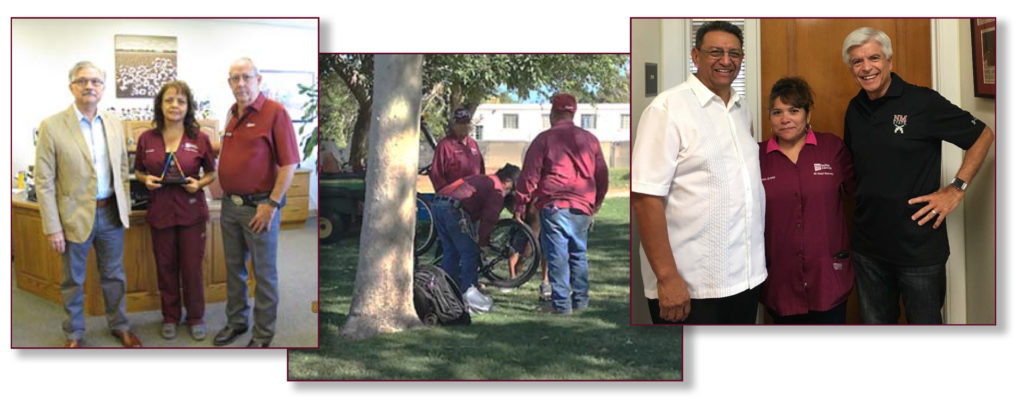In the 1970s, New York Congressperson Shirley Chisholm, the first Black woman elected to the U.S. Congress and the first Black candidate to seek a major party nomination for president, said, “If they don’t give you a seat at the table, bring a folding chair.”
The phrase is tossed around a lot, but what does “a seat at the table” mean for us in facilities management? Representative Chisholm was primarily referring to her challenges as a Black female, of course, but our usage refers to how the facilities department can, and should, play a role in important conversations and meetings across campus where decisions are made that affect the success of the institution. After all, buildings and infrastructure are among the most significant institutional financial investments, and the vital role of the campus buildings and grounds in student recruitment and retention is well documented.
When I joined New Mexico State University (NMSU) in 2008 as assistant vice president of the Office of Facilities, the campus counted on our department for maintenance and operations. We compiled the department’s capital outlay requests and presented them to the state. Our team managed construction projects, both large and small. However, when it came down to the real decisions, those were pretty much handed to us, often leaving us questioning the decision-making process.
Our leadership team decided that to earn that proverbial seat at the table, we needed to be considered more than just “the maintenance department.” And so, from shortly after I was hired until I retired as associate vice president of Facilities Services in 2019, I worked with my colleagues to earn and keep that seat, even if it meant bringing our own folding chair at first.
Strategic steps forward
Our first goal was to improve the image of the department. The NMSU campus community tended to think of facilities as “maintenance,” and after teaching quite a few APPA Supervisor’s Toolkits, I knew we were not the only institution where this was the norm. The campus also separated into cliques and stereotypes. Administration vs. faculty. One college competed against another. Athletics and academics debated their role. Facilities folks, too, did this internally sometimes. I made a reference to “skilled trades” in conversation at a Rocky Mountain APPA (RMA) conference once, and John Morris, then with the University of Colorado and the region president, told me that he dropped that term “skilled” from his vocabulary because everyone in his group was a “skilled professional.” That stuck with me. So we at NMSU adopted the same philosophy, after which our staff were referred to as professional facilities management employees, from the custodians and groundskeepers to the executive directors.
We were aided in our effort after a reorganization brought Environmental Health and Safety (EHS) under my purview as the associate vice president of the Office of Facilities Services and, thus, onto our team. The director of EHS was initially unhappy about this new arrangement, so we asked her to lead a committee to identify a new departmental name and help improve our image. Thus, we became Facilities Services. This new name provided justification to publish a series of newsletters detailing the different units in our organization and their achievements. Our first lesson, then, was: Pay attention to and cultivate your image.

Author Glen Haubold (front row, center) with the Facilities Services leadership team at New Mexico State University.
Our leadership team in Facilities Services had three people with earned doctorates: the executive director of EHS, the executive director of business services, and the university engineer (in electrical engineering). The university architect had studied in Europe and completed her master’s degree. Our leadership team was also diverse; we had three women, one of whom was Hispanic. These impressive credentials gave us some “street cred” with academics on campus, and we mentioned these backgrounds in numerous newsletters. That was our next lesson: Communicate your team’s achievements.
To that end, we also became prolific at distributing email newsletters to the campus community. In keeping with our focus on professionalism, we talked about the training that staff had attended, even when this training was routine recertification. We illustrated how we used the APPA Facilities Performance Indicators data to benchmark our staffing and budget, and we made sure to discuss performance standards. For example, the campus community was surprised to learn that our custodians had time and task standards. We made sure not to exaggerate and to back up our information with data. We recognized everyone’s accomplishments. When we applied for the APPA Award for Excellence and were granted a site visit, we engaged the campus in the interviews. After we received the award, we made sure that everyone was recognized. Okay, maybe we bragged, but people began thinking of Facilities Services as a professional facilities management organization that employed best practices.
Our third lesson addressed the fact that facilities organizations sometimes tend to isolate, thinking that “no one understands us.” Instead, we should both hone and tout our message, internally within the department as well as externally. An excellent and easy way to get engaged with the campus community is through serving on ad hoc committees such as search committees. Sometimes committee members are recruited; other times, volunteers are solicited through campus communications. We kept our ears to the ground, and when a leadership vacancy opened with a search, I would email the hiring manager saying that I thought Facilities Services should have a voice in the selection. These inquiries usually resulted in being asked to “volunteer” someone. Whether ad hoc or standing, all committees can be great opportunities to meet and partner with others on campus.
The bottom line? Our third lesson: Become active members of the campus community. For just one example of how this can pay off, remember that the people hired through search committees are the next campus leaders, and serving on a search committee that concludes with a successful hire can help you build relationships.

NMSU Facilities Services staff exemplify lesson three of Haubold’s article (“become active members of your campus community”). The images above show a custodian being recognized for providing assistance to a student who was in trouble; a groundskeeper helping a student change a bicycle tire; and another custodian being recognized for cleaning a flooded dorm room.
Improving our image, serving on search committees, and being among the first to meet new campus leaders led to creating rapport with others across campus, which we then leveraged into invitations to various planning meetings. We found ourselves on ad hoc committees, made our way to the key performance indicator subcommittee of the strategic planning committee, and were invited to the president’s cabinet to explain the capital outlay process and how billing for utilities was managed. Our folding chair was beginning to feel permanent, hence our fourth lesson: Be patient.
Meetings on any institutional campus tend to be attended by people who can detail why a new idea will not work. When Manuel T. Pacheco arrived at NMSU as the interim president in 2009, he had served as president of four universities and interim president at another. At our first administrative council meeting, Dr. Pacheco told the university leadership that he wanted his administrative team to work on getting to “Yes” instead of developing roadblocks.
We took that idea and ran with it. We wanted Facilities Services to become known as the folks with solutions. Creative problem-solving is something most of us do well, and it is an excellent path to being invited to more decision-making meetings. Lesson five is: Offer solutions and get to “yes.” Looking for answers instead of roadblocks is another good practice for discussions and meetings.
Writing in Forbes, Shellye Archambeau, one of the tech industry’s first Black female CEOs, shared an oft-repeated story about legendary football coach Vince Lombardi. When Travis Williams danced after scoring a touchdown, the coach told the great kick returner, “Travis, the next time you make it to the end zone, act like you’ve been there before.”
Similarly, when our facilities department began participating in these decision-making meetings, we had already learned our sixth lesson: Prepare thoroughly. A question by the new provost about space management prompted us to offer to be the engagement manager for a classroom utilization study, which we followed with a request for a new space manager position that was approved. We had been following the developments in space management and were the most knowledgeable people in the room.
Becoming the go-to
Facilities management is what we do, from campus-wide emergencies to mundane activities like hanging homecoming banners. I would challenge anyone to find a campus issue that does not have some sort of interaction with utilities, buildings, grounds, or construction. Whether it’s an initiative to increase the research funding stream, advance student recruitment and improve retention, or improve attendance at sports events, facilities management has a role. To use that seat at the table to its full potential for the benefit of our institutions, we should strive to be familiar with current best practices and trends, like quick readiness of space for a cluster research hire, creating and identifying campus photo opportunities, or creating club seating areas at athletic events. We want to be the go-to people for facilities-related concerns—which are just about every important issue on campus.
That being said, I like the recommendation by Paolina Milana, a life coach, to “bring your signature dish” (lesson seven). This was her way of saying, in effect, that professionals should stay in their lanes and become experts in their field. I would just add a few words of caution: The deferred maintenance challenge is accompanied by a number large enough to dent the national debt, and continuous recitation of this or any other problem without solutions tends to fall on desensitized ears. We need to demonstrate our expertise in all facilities issues on campus; if deferred maintenance is your issue, bring solutions.
Finally, as we in NMSU’s Facilities Services department began to fully engage with the campus community in the decision-making process, we quickly realized that not every discussion is a battle to be won. In an oft-repeated quote, Ronald Reagan was fond of telling his aides, “I’d rather get 80 percent of what I want than go over the cliff with my flag flying.” Sometimes we got only a little of what we wanted, but we kept in mind the knowledge that having that seat at the table meant we would be around for further discussions. We often found that it was easier to get the results we wanted by compromising or giving in and cultivating relationships to be able to make our point later. Our eighth lesson, choose your battles wisely, paves the path to success.
Collectively, the results of our years-long efforts within NMSU’s Facilities Services department were positive. Our first business manager went on to be the vice president for business at Doña Ana Community College, an NMSU System component. Our leadership team was regularly sought after to join ad hoc committees. We were on the writing teams for university reaccreditation. We led the annual capital request meetings. By the time I retired in 2019, I had been asked to co-chair the committee that was charged with oversight of the NMSU Strategic Plan. Facilities Services had started by bringing a folding chair, but because of our positive and sustained efforts in good faith, we were often seated at the head of the table.
Glen Haubold is an APPA Fellow and Member Emeritus with years of service to APPA as well as its CAPPA and RMA regions. He was co-principal investigator for the APPA Center for Facilities Research (CFaR) research project, “Facilities Budgets: Issues with Recovery and Recharge in Higher Education.” He can be reached at [email protected].



